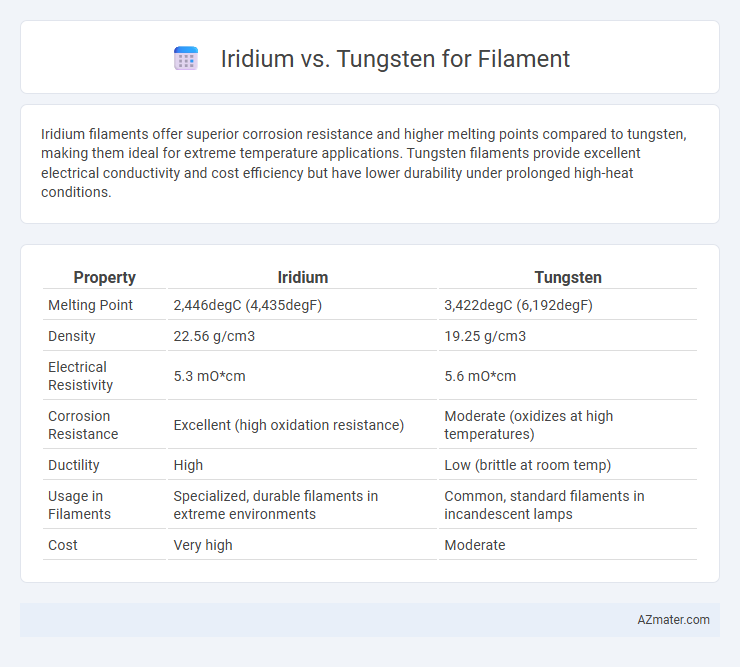Iridium filaments offer superior corrosion resistance and higher melting points compared to tungsten, making them ideal for extreme temperature applications. Tungsten filaments provide excellent electrical conductivity and cost efficiency but have lower durability under prolonged high-heat conditions.
Table of Comparison
| Property | Iridium | Tungsten |
|---|---|---|
| Melting Point | 2,446degC (4,435degF) | 3,422degC (6,192degF) |
| Density | 22.56 g/cm3 | 19.25 g/cm3 |
| Electrical Resistivity | 5.3 mO*cm | 5.6 mO*cm |
| Corrosion Resistance | Excellent (high oxidation resistance) | Moderate (oxidizes at high temperatures) |
| Ductility | High | Low (brittle at room temp) |
| Usage in Filaments | Specialized, durable filaments in extreme environments | Common, standard filaments in incandescent lamps |
| Cost | Very high | Moderate |
Introduction to Filament Materials
Iridium and tungsten are two prominent filament materials used in high-temperature applications due to their exceptional melting points and durability. Tungsten, widely favored for its high tensile strength and thermal conductivity, operates efficiently in incandescent bulbs and electron tubes. Iridium, though less common, offers superior corrosion resistance and stability at extreme temperatures, making it ideal for specialized scientific instruments and harsh environments.
Overview of Iridium and Tungsten
Iridium and tungsten are both refractory metals prized for their high melting points and durability, making them ideal choices for filament materials in specialized applications. Iridium boasts a melting point of approximately 2446degC and exceptional corrosion resistance, while tungsten has the highest melting point among metals at 3422degC, offering superior heat tolerance. Tungsten filaments are widely used in incandescent bulbs due to their longevity and efficiency, whereas iridium's rarity and hardness make it suitable for niche applications requiring extreme durability.
Physical Properties: Iridium vs Tungsten
Iridium exhibits a melting point of approximately 2,447 degC, which is slightly lower than tungsten's exceptionally high melting point of about 3,422 degC, making tungsten more suitable for high-temperature filament applications. Despite this, iridium offers superior corrosion resistance and mechanical strength at elevated temperatures, beneficial in harsh operating environments. Tungsten's high density (19.25 g/cm3) and brittle nature contrast with iridium's moderate density (22.56 g/cm3) and enhanced ductility, influencing filament longevity and performance under mechanical stress.
Melting Points and Heat Resistance
Iridium has a melting point of approximately 2,446degC, significantly higher than tungsten's 3,422degC, making tungsten more suitable for high-temperature filament applications. Tungsten's superior heat resistance and thermal stability allow filaments to operate efficiently at elevated temperatures without melting. Despite iridium's corrosion resistance, tungsten remains the preferred material for filament manufacturing due to its exceptional melting point and durability under intense heat.
Electrical Conductivity Comparison
Iridium exhibits lower electrical conductivity than tungsten, with iridium's conductivity around 1.3 x 10^7 S/m compared to tungsten's approximately 1.8 x 10^7 S/m. Tungsten's superior electrical conductivity makes it more efficient for filament applications requiring minimal resistive heat loss and stable current flow. Despite this, iridium's higher melting point and corrosion resistance offer advantages in extreme environments, but tungsten remains the preferred material for filaments due to its optimal conductivity and mechanical durability.
Durability and Lifespan
Iridium filaments exhibit exceptional durability due to their high melting point of approximately 2,466degC and superior resistance to oxidation, significantly outperforming tungsten filaments that melt at around 3,422degC but suffer from faster degradation under high temperatures. Tungsten, while commonly used in incandescent bulbs for its high melting point and availability, has a shorter lifespan because it evaporates more quickly during operation, leading to filament thinning and eventual breakage. Iridium's robust chemical stability and lower evaporation rate extend filament lifespan considerably, making it ideal for high-performance and long-lasting applications.
Cost and Availability
Iridium filaments are significantly more expensive than tungsten due to the rarity and difficulty in processing iridium, which impacts overall production costs. Tungsten is widely available and more cost-effective, making it the preferred choice for most filament applications in lighting and electronics. Despite its higher cost, iridium offers superior melting points and durability, but tungsten's balance of performance, cost, and accessibility ensures its dominant use in filament manufacturing.
Applications in Lighting and Electronics
Iridium filaments excel in specialized lighting applications requiring extreme heat resistance and oxidation stability, such as high-intensity discharge lamps and scientific instruments. Tungsten filaments dominate general lighting and electronics due to their high melting point, excellent electrical conductivity, and cost-effectiveness in incandescent bulbs and vacuum tubes. Both materials contribute to improving energy efficiency and durability in lighting and electronic components, with iridium favored for precision use and tungsten for widespread commercial implementation.
Environmental and Safety Considerations
Iridium filaments exhibit superior corrosion resistance and higher melting points compared to tungsten, resulting in longer lifespan and reduced material waste in high-temperature applications. Tungsten, while more abundant and less expensive, poses greater environmental challenges due to its mining impact and potential for releasing harmful dust during processing. Safety considerations favor iridium filaments for critical environments because their durability minimizes filament failure risks and associated hazards in lighting and electronic devices.
Conclusion: Choosing the Right Filament Material
Iridium and tungsten each offer distinct advantages as filament materials in high-temperature applications, with iridium providing superior melting points and corrosion resistance, while tungsten excels in tensile strength and thermal conductivity. Selecting the right filament material depends on the specific operational environment, application requirements, and longevity expectations. For environments demanding extreme heat resistance and durability, iridium is optimal, whereas tungsten remains the preferred choice for cost-effective, high-performance filaments with excellent electrical conductivity.

Infographic: Iridium vs Tungsten for Filament
 azmater.com
azmater.com